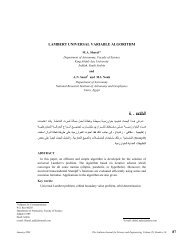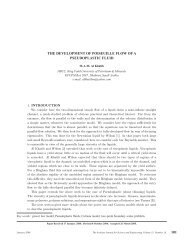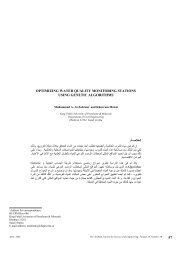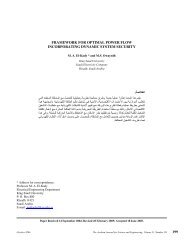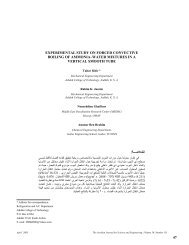pp. 345-360 - Arabian Journal for Science and Engineering
pp. 345-360 - Arabian Journal for Science and Engineering
pp. 345-360 - Arabian Journal for Science and Engineering
Create successful ePaper yourself
Turn your PDF publications into a flip-book with our unique Google optimized e-Paper software.
*Address <strong>for</strong> correspondence:<br />
Department of Physics<br />
University of Baghdad<br />
Baghdad, Iraq<br />
E-mail: drmhj54@yahoo.com<br />
AN ION BEAM TRANSPORT DESIGN OPTIMIZATION IN A<br />
MEDIUM RANGE ION IMPLANTER SYSTEM<br />
Mahdi Hadi Jasim*<br />
Department of Physics, College of <strong>Science</strong>, University of Baghdad<br />
Baghdad, Iraq<br />
: ﺔـﺻﻼﺨﻟا<br />
ﺪﻳﺪﺤﺗ ﻊﻣ ﻲﻧﻮﻳأﻻا<br />
عرﺰﻟا ﺔﻣﻮﻈﻨﻣ ﻲﻓ ﺔﻠﻗﺎﻨﻟا ﺔﻣﺰﺤﻟا<br />
ﺮﻴﺌﺒﺗ جذﻮﻤﻧ ﻦﺴﺤﺗ زﺎﺠﻧإ<br />
- ﺚﺤﺒﻟا اﺬه ﻲﻓ – ﻢﺗ ﺪﻘﻟ<br />
تﻻدﺎﻌﻣ ﺖﻘُﺘﺷا<br />
ﺪﻗو . نﻮﺤﺸﻤﻟا ﻢﻴﺴﺠﻟا ﻰﻠﻋ ﺮﺛﺆﺗ ﻲﺘﻟا ﺎﻬﺗﺎﻤﻠْﻌَﻣ<br />
ﻊﻣ ﺔﻴﺴﻴﺋﺮﻟا<br />
ﺔﻳﺮﺼﺒﻟا ﺮﺻﺎﻨﻌﻟا لﺎﻤﻌﺘﺳا<br />
تﺎﻳﻮﺘﺴﻤﻟا ﺪﻨﻋ ﺔآﺮﺤﻟا نأ رﺎﺒﺘﻋﻻﺎﺑ<br />
ﻦﻳﺬﺧﺁ<br />
يﺮﺼﺑ ﺮﺼﻨﻋ ﻞﻜﻟ تﺎﻓﻮﻔﺼﻤﻟا ﻊﻣ ﺔﻧﻮﺤﺸﻤﻟا تﺎﻤﻴﺴﺠﻠﻟ ﺔآﺮﺤﻟا<br />
. ﺔﻴﻟﺎﺜﻤﻟا ﻰﻟإ بﺮﻗﻷا ﺔﻣﺰﺤﻟا تﺎﻤﻠﻌﻣ ﻰﻠﻋ لﻮﺼﺤﻟا ضﺮﻐﻟ نﺎﻴﺒﻳﺮﻘﺗ ﺪﻤﺘﻋاو<br />
. ﺎﻬﻨﻣ ﻞﻜﻟ ﺔﻠﻘﺘﺴﻣ نﻮﻜﺗ ﺔﻔﻠﺘﺨﻤﻟا<br />
: ﺪﻌﺒﻟا ﻲﻋﺎﺑر ﺪﻨﻋ ﺔﻣﺰﺤﻟا ﻞﻜﺷ لوﻻا ﺐﻳﺮﻘﺘﻟا ﻲﻓ<br />
( ) ( ) T<br />
out R.σ<br />
in . R<br />
σ =<br />
ﺐﻄﻘﻟا ﻲﻋﺎﺑر)<br />
ﻰﻟوﻷا<br />
ﺔﺟرﺪﻟاو ( ﺐﻄﻘﻟا ﻲﺋﺎﻨﺜﻟا قﺎﻴﺴﻧﻻا ﺰّﻴﺣ)<br />
ﺮﻔﺼﻟا ﺔﺟرد ﻲﻓ ﺔﻣﺰﺤﻟا ﻞﻘﻧ زﺎﺠﻧإو<br />
ﺪﻗو<br />
. ﺔﻴﺋﺎﻀﻔﻟا ﺎﻬﺗﺎﻴﺛاﺪﺣإ ﺔﺣﺎﺴﻣ ﺪﻨﻋ ﻲﺳوﺎﺟ<br />
ﻞﻜﺸﺑ تﺎﻤﻴﺴﺠﻟا ﻊﻳزﻮﺗ نﻮﻜﻳ<br />
ﻲﻧﺎﺜﻟا ﺐﻳﺮﻘﺘﻟا ﻲﻓو<br />
.( ﺲﻴﻃﺎﻨﻐﻤﻟاو<br />
ﻚﻠﺘﻤﻳ ﺎﻤهﻼآو نﻮﺤﺸﻤﻟا ﻢﻴﺴﺠﻟا ﺔﻗﺎﻄﻟ ًاﺮﻴﺛﺄﺗ<br />
ﺮﺜآأ نﻮﻳﻷا<br />
ﺔﻣﺰﺤﻟ عﻮﻄﺴﻟاو ثﺎﻌﺘﺑﻻا تﻼﻣﺎﻌﻣ<br />
تﺎﺑﺎﺴﺣ نأ<br />
ﺪﺟُو<br />
. ﺔﺘﺑﺎﺛ ﺔﻳرﺎﻴﻌﻣ ﺔﻤﻴﻗ<br />
ﺔﻣﻮﻈﻨﻣ ﻊﻣ يﺮﺼﺑ ﺮﺼﻨﻋ ﻞﻜﻟ<br />
ﺔﻴﻤﻴﻤﺼﺘﻟا<br />
تﺎﻤﻠﻌﻤﻟا ﺮﻴﺛﺄﺗو ﻊﻗﻮﻣ ﻒﻳﺮﻌﺗ ﻲﻓ ﻢﻴﻴﻘﺗو ﺔﻧرﺎﻘﻣ ءاﺮﺟا ﻢﺗو<br />
. نﻮﻳﻷا<br />
عرﺰﻠﻟ ةﺮﻓﻮﺘﻣ<br />
Paper Received 26 August 2006; Revised 30 August 2007; Accepted 28 November 2007<br />
Mahdi Hadi Jasim<br />
July 2008 The <strong>Arabian</strong> <strong>Journal</strong> <strong>for</strong> <strong>Science</strong> <strong>and</strong> <strong>Engineering</strong>, Volume 33, Number 2A <strong>345</strong>
346<br />
Mahdi Hadi Jasim<br />
ABSTRACT<br />
An improvement of the transport beam focusing model in an ion implanter system<br />
has been achieved, with the definition of the main optical elements used <strong>and</strong> their<br />
parameters’ effect on charged particles. The equations of motion of charged particles<br />
<strong>and</strong> matrices in each optical element have been derived, with consideration of the<br />
motion in different planes. Two assumptions were made in obtaining the optimized<br />
beam parameters. In the first assumption, the four-dimensional beam ellipsoid<br />
( ( ) ( ) T<br />
σ out = R.σ<br />
in . R ), the beam transport is accomplished in zero order (drift space<br />
<strong>and</strong> dipole) <strong>and</strong> first order (quadrupole <strong>and</strong> magnet). In the second assumption, the<br />
particle distribution is normal in the area of its space coordinates. Calculations of the<br />
emittance <strong>and</strong> the brightness factors of the ion beam are found to be more affected by<br />
the energy of charged particles. The emittance <strong>and</strong> brightness have constant<br />
normalized values.<br />
A comparison <strong>and</strong> evaluation was made of the definition of the location <strong>and</strong> the<br />
effect of the designed parameters <strong>for</strong> each optical element within the available ion<br />
implantation design system.<br />
Key words: transport beam focusing, ion implanter system, four dimensional beam<br />
ellipsoid, emittance <strong>and</strong> brightness factors<br />
The <strong>Arabian</strong> <strong>Journal</strong> <strong>for</strong> <strong>Science</strong> <strong>and</strong> <strong>Engineering</strong>, Volume 33, Number 2A July 2008
Mahdi Hadi Jasim<br />
AN ION BEAM TRANSPORT DESIGN OPTIMIZATION IN A MEDIUM RANGE ION<br />
IMPLANTER SYSTEM<br />
1. INTRODUCTION<br />
Ion implantation is a powerful technique <strong>for</strong> modifying the near surface properties of material, so it is important in<br />
CMOS a<strong>pp</strong>lications. To design an ion implanter system, the behavior of the ion beam passing through its elements must<br />
be understood. There<strong>for</strong>e, it is necessary to study the transport of charged particle ion beams during their passage<br />
through the ion implanter system. Such studies give much in<strong>for</strong>mation about the charged particle ion beam, such as the<br />
quality of implanted ions, the beam size, <strong>and</strong> the focusing regions along the ion beam path. Many studies have a<strong>pp</strong>eared<br />
in this field, which have mainly resulted in the improvement of the ion implantation systems. Gillespie et al. [1]<br />
developed a set of optical models <strong>for</strong> a variety of electrostatic lenses <strong>and</strong> accelerator columns <strong>for</strong> the computer code<br />
TRACE 3-D. This code is an envelope (matrix) code including space charge often used to model bunched beams in<br />
magnetic transport systems <strong>and</strong> radiofrequency (R.F.) accelerators when the effects of beam current may be important.<br />
TRACE 3-D uses the first-order transfer matrix (R-matrix) <strong>for</strong>malism to compute changes in the beam matrix (σ -matrix).<br />
A computer code to measure the beam emittance <strong>and</strong> beam parameters of the ATR line has been produced by Tsoupas et<br />
al. [2]. This code included a theoretical <strong>for</strong>malism <strong>for</strong> the method <strong>for</strong> the measurement of the beam emittance, <strong>and</strong> on<br />
how to obtain the σ -matrix using the R-matrix. The transverse linear optics of a charged particle storage ring has been<br />
studied [3]. This present work deals with a 4-dimensional phase space <strong>and</strong> normalized phase space in two cases. Firstly<br />
it treats the x <strong>and</strong> y spaces as an invariant subspaces, <strong>and</strong>, secondly when the x <strong>and</strong> y spaces are coupled.<br />
This work is aimed to study the behavior of a charged particles ion beam in different elements of the ion implanter<br />
system. The equations of motion of the charged particle beam passing through each element of ion implanter system<br />
have been modeled.<br />
2. THEORETICAL FORMALISM<br />
In this work a beam extracted from a medium-range ion implanter is considered to be an upright ellipse with semi<br />
axes.<br />
The general algebraic equation of an ellipse centered on the origin is:<br />
where M m is a positive definite symmetric matrix ,<br />
T<br />
X M m X = D<br />
(1)<br />
M m =<br />
T<br />
x<br />
X : is the transpose matrix of X , X = , x, x′<br />
are the particle’s position <strong>and</strong> angular divergence in the radial<br />
x′<br />
direction, respectively.<br />
The shape of the elliptical beam depends on the value of the constant: <strong>for</strong> B =0, a right plane space ellipse is obtained<br />
which is always defined as a minimum beam size or beam waist [4,5]. The existence of the latter depends on the nature<br />
of the elliptical beam.<br />
Based on Liouville's theorem [6,7] the determinant of the Mm -matrix is equal to unity (D=1). So Equation (1)<br />
becomes:<br />
X T Mm X = 1 (2)<br />
By considering (σ ) as the inverse of Mm -matrix<br />
A<br />
B<br />
C<br />
July 2008 The <strong>Arabian</strong> <strong>Journal</strong> <strong>for</strong> <strong>Science</strong> <strong>and</strong> <strong>Engineering</strong>, Volume 33, Number 2A 347<br />
B<br />
⎡<br />
⎤<br />
=<br />
−1<br />
σ<br />
=<br />
11 σ<br />
σ M<br />
12<br />
⎢<br />
⎥ , (3)<br />
m<br />
⎢⎣<br />
σ12<br />
σ 22 ⎥⎦<br />
where (σ ) is the phase space matrix, then the equation defining the ellipse may be written as:<br />
T −1 X σ X = 1<br />
(4)
348<br />
Mahdi Hadi Jasim<br />
Or equivalently:<br />
2<br />
2<br />
σ x − 2σ<br />
xx′<br />
+ σ x′<br />
= detσ<br />
(5)<br />
22<br />
12<br />
11<br />
A typical output elliptical beam characterized by<br />
11<br />
,<br />
22<br />
σ σ , <strong>and</strong> σ<br />
12<br />
is illustrated in Figure 1 [8].<br />
The beam envelope is represented by the maximum spatial extent of the ellipse (xmax = σ 11 ), <strong>and</strong> also the maximum<br />
angular divergence of the beam within the phase ellipse (x'max = σ 22 ). The parameter ( σ<br />
12<br />
) defines the orientation of<br />
the ellipse relative to the x <strong>and</strong> x' axes.<br />
The correlation term (r) is given in terms of the off-diagonal elements of σ -matrix [6,9], i.e.<br />
r<br />
ij<br />
=<br />
σ<br />
ij<br />
σ σ<br />
ii jj<br />
. (6)<br />
σ<br />
In the case of a two dimensional ellipse r<br />
12<br />
12<br />
= , the particles of phase space ellipse have a normal Gaussian<br />
σ<br />
11<br />
σ<br />
22<br />
distribution [2]. Under the linear trans<strong>for</strong>mation, the normal distribution of particles in the ellipse is trans<strong>for</strong>med into<br />
another normal distribution.<br />
To find the relation between σ -matrices at two positions of the beam line, i.e. σ (out)<br />
) <strong>and</strong> ( σ (in)<br />
, the equation of<br />
the ellipse can be used at input location:<br />
X<br />
T<br />
( in)<br />
σ ( in)<br />
−1<br />
X ( in)<br />
= 1,<br />
(7)<br />
while at the output location it is:<br />
X<br />
T<br />
( out)<br />
σ ( out)<br />
−1<br />
X ( out)<br />
= 1<br />
(8)<br />
By using a linear trans<strong>for</strong>mation, Equation (1) <strong>and</strong> the identity (RR -1 =1), the equation (7) can be written as:<br />
Also equation (9) becomes:<br />
( RX ( in))<br />
T<br />
( Rσ<br />
( in)<br />
R<br />
T<br />
)<br />
−1<br />
( RX ( in))<br />
= 1<br />
(9)<br />
X<br />
T<br />
( out)(<br />
Rσ<br />
( in)<br />
R<br />
T<br />
)<br />
−1<br />
R(<br />
out)<br />
= 1<br />
(10)<br />
Equation (8) <strong>and</strong> Equation (10) after inversion can be written as:<br />
σ ( out ) = Rσ<br />
( in)<br />
R<br />
T<br />
(11)<br />
Equation (11) represents the relation between theσ -matrix in two locations of the beam line. Also based on<br />
Liouville's theorem [6, 7], the trans<strong>for</strong>mation has preserved the phase space volume of the beam <strong>and</strong> (det σ (in)<br />
=<br />
det σ (out)<br />
).<br />
The area of phase space ellipse is equal to (π det σ (out)<br />
), there<strong>for</strong>e, the emittance is:<br />
The normalized emittance isε n = βγε ; where = vi / c<br />
γ = ( 1 − β<br />
2<br />
)<br />
−1/<br />
2<br />
.<br />
ε = detσ<br />
= ( σ σ − σ )<br />
(12)<br />
The <strong>Arabian</strong> <strong>Journal</strong> <strong>for</strong> <strong>Science</strong> <strong>and</strong> <strong>Engineering</strong>, Volume 33, Number 2A July 2008<br />
11<br />
22<br />
2<br />
12<br />
β ; c: velocity of light in vacuum; i<br />
v : ion velocity;
The normalized brightness ( B r ) varies across the beam by:<br />
xn<br />
yn<br />
Mahdi Hadi Jasim<br />
I<br />
Br<br />
π ε ε<br />
2<br />
2<br />
= , (13)<br />
where I is the total ion beam current.<br />
The beam distribution at any point along the transport lines can be described mathematically by a four dimensional<br />
beam ellipsoid ( x, x′<br />
, y,<br />
y′<br />
) which can be expressed by a 4× 4 symmetric matrix ( σ − matrix ), see Figure 1. As shown in<br />
the A<strong>pp</strong>endix (Tables A1, A2, <strong>and</strong> A3) the terms of theσ − matrix <strong>and</strong> the trans<strong>for</strong>mation Rij − matrix have been<br />
derived. They include the main effective parameters <strong>and</strong> the beam ellipsoid <strong>for</strong> different optical elements in the ion<br />
implanter system.<br />
x'<br />
x'int =<br />
Beam centroid<br />
3. RESULTS AND DISCUSSIONS<br />
Based on the theoretical calculations <strong>for</strong> a 4 × 4 symmetric σ − matrix <strong>and</strong> its trans<strong>for</strong>mation Rij − matrices, an<br />
optimization procedure has been per<strong>for</strong>med <strong>for</strong> different optical elements in an ion implanter system, as shown in Figure<br />
2. The main input parameters, Table 1, were used to calculate the beam profiles (beam width) <strong>for</strong> a slit extraction as a<br />
function of the system’s length, as shown in Figure 3, <strong>for</strong> the horizontal plane <strong>and</strong> vertical plane, respectively. The<br />
specifications are: bending angle 75 o 2<br />
, R=430mm, slit extraction dimensions = (5 ± 0.04)× (20 ± 0.0006) mm ,<br />
S1=410mm <strong>and</strong> S2=175mm. The phase space ellipse movement of ion implanter elements is shown in Figure 4 <strong>for</strong> the<br />
horizontal plane, where the region of divergence or convergence of the ion beam indicates the effect of the acceleration<br />
tube <strong>and</strong> the deflector units.<br />
The bending magnet works as a strong focusing element through selection of the pole-face<br />
angles( = . 3°<br />
, β = −0.<br />
5°<br />
β act a thin divergence lens in the<br />
α m 20 m ),where the entrance angle α m <strong>and</strong> exit angle m<br />
horizontal plane <strong>and</strong> as a thin convergence lens in the vertical plane. The effect of the fringe field on the ion beam is<br />
represented by the reduction of the entrance angle (ψ ) which has a small value in the case of a homogeneous magnetic<br />
field. In the present work, ψ is found to be 0.03°. The minimum <strong>and</strong> maximum beam paths inside the good field region<br />
allowed a magnetic field strength ranging from 2000 to 4000 G <strong>for</strong> the extraction voltage range (15–35 kV). The<br />
magnetic field strength reached 0.396T <strong>and</strong> the magnetic rigidity reached 0.17T.m, <strong>for</strong> Ar + ion beams.<br />
The maximum acceleration voltage (180 kV) is reached using a high voltage electrostatic accelerator type (HERP<br />
Germany). It is found that an increase in the acceleration energy causes a decrease in non-linearity in the phase space<br />
ellipse at the target <strong>for</strong> both planes <strong>and</strong> a decrease in the total area. The decrease in the total area is proportional to the<br />
acceleration voltage ( ) 2 / 1<br />
U<br />
Figure 1. Two-dimensional phase space ellipse based on the σ -matrix [8]<br />
U .<br />
o<br />
detσ<br />
σ11 x'max = σ 22<br />
xmax = σ 11<br />
July 2008 The <strong>Arabian</strong> <strong>Journal</strong> <strong>for</strong> <strong>Science</strong> <strong>and</strong> <strong>Engineering</strong>, Volume 33, Number 2A 349<br />
σ12<br />
σ11<br />
xint =<br />
σ<br />
Slope =<br />
σ<br />
x<br />
detσ<br />
σ 22<br />
12<br />
11
350<br />
Mahdi Hadi Jasim<br />
The effect of triplet quadrupole lenses has been studied in comparison with the upright phase space ellipse in the<br />
extraction region which shows a divergence effect in the horizontal plane. The triplet quadrupole lens consists of three<br />
quadrupole parts with dimensions described in Table 1. However, in the vertical plane there is no clear effect of the<br />
quadrupole lens due to the small value of initial angular divergence (y').<br />
The deflector causes deflection of the desired charged particle beam with an angle proportional to the potential<br />
difference between the deflector plates. The deflector causes a shift in the distance <strong>and</strong> in the angular divergence of the<br />
phase space ellipse in both horizontal <strong>and</strong> vertical planes, as shown in Figure 4.<br />
The lengths of free regions were calculated <strong>and</strong> found to be consistent with the minimum physical element to element<br />
separation as well as with the overall implanter system. The length of the first field free region has a strong effect on the<br />
total area of ion beam at the target as shown in Figure 5. From this figure the minimum value of the total area of ion<br />
beam at the target is 237.29 mm 2 <strong>and</strong> that means the silicon wafer area (5cm in diameter) is covered at least by eight<br />
regions with homogenous doping.<br />
At the target region, the ion beam has divergence properties in both the horizontal <strong>and</strong> vertical plane as shown in<br />
Figures 6 <strong>and</strong> 7. This region shows a shift in the phase-space ellipse due to the influence of the deflector.<br />
80<br />
Bending<br />
system<br />
410<br />
Acceleration<br />
tube<br />
Bending<br />
line<br />
175<br />
75 o<br />
Decelerator<br />
Ion source<br />
1000<br />
Lenses tube<br />
3<br />
945<br />
Scanner<br />
Target<br />
(not to scale )<br />
Figure 2. Top view of ion implanter system with the calculated optimized positions <strong>for</strong> each optical element (all dimensions in<br />
mm)<br />
The <strong>Arabian</strong> <strong>Journal</strong> <strong>for</strong> <strong>Science</strong> <strong>and</strong> <strong>Engineering</strong>, Volume 33, Number 2A July 2008<br />
25<br />
6.66 o<br />
Electron<br />
shower<br />
1150<br />
300<br />
1000
Mahdi Hadi Jasim<br />
Table 1. The Specific Optimization Values <strong>for</strong> the Optical Element Used in the Ion Implantation System <strong>and</strong><br />
Evaluation of the Available Designed Values in IMIIIS.<br />
Optical element<br />
Parameters<br />
Fixed Optimizati<br />
Slit Extractor<br />
Homogenous<br />
Magnet Analyzer<br />
Accelerating tube<br />
Quadrupole Triplet<br />
Deflector plates<br />
Drift free space<br />
between the optical<br />
elements<br />
Extraction voltage (kV)<br />
Extraction current (mA)<br />
xo (mm)<br />
x'o (rad.)<br />
yo (mm)<br />
y'o (rad.)<br />
Entrance angle (degree)<br />
Deflection angle (degree)<br />
Exit angle (degree)<br />
Fringing field effect angle (degree)<br />
Magnet radius (mm)<br />
Magnet rigidity (T. m)<br />
Magnet field strength (T)<br />
Magnet gap (mm)<br />
Acceleration voltage (kV)<br />
Final energy of charged particle(keV)<br />
Acceleration tube length (mm)<br />
Length (mm)<br />
Distance between the lenses (mm)<br />
Operation voltage (V)<br />
Distance between electrodes (mm)<br />
Total length (mm)<br />
Length (mm)<br />
Plates distance (mm)<br />
Potential difference (V)<br />
Deflection angle (degree)<br />
S1-First free region length (mm) S2-<br />
Second free region length (mm)<br />
S3-Third free region length (mm)<br />
S4-Fourth free region length (mm-)<br />
S5-Fifth free region length (mm)<br />
* Iraqi Ministry of Industry ion implantation system (IMIIIS).<br />
Design values*<br />
15–35<br />
2.23<br />
5<br />
.04<br />
20<br />
on values<br />
July 2008 The <strong>Arabian</strong> <strong>Journal</strong> <strong>for</strong> <strong>Science</strong> <strong>and</strong> <strong>Engineering</strong>, Volume 33, Number 2A 351<br />
.0006<br />
-----<br />
75<br />
-----<br />
-----<br />
430<br />
0.2276<br />
0.5293<br />
80<br />
0-180<br />
215<br />
1000<br />
-----<br />
-----<br />
-----<br />
-----<br />
-----<br />
------<br />
------<br />
------<br />
------<br />
------<br />
------<br />
------<br />
------<br />
------<br />
15-35<br />
2.23<br />
5<br />
0.04<br />
20<br />
0.0006<br />
20.3<br />
75<br />
–0.5<br />
0.03<br />
430<br />
0.17032<br />
0.396<br />
80<br />
0-180<br />
215<br />
1000<br />
100<br />
20<br />
250<br />
30<br />
440<br />
4. CONCLUSION<br />
Equations of motion of the charged particles <strong>and</strong> the matrices in each optical element have been derived, with the<br />
consideration that the motions in different planes are independent of each other. An optimization of the beam parameter<br />
design at the target wafer has been obtained using two assumptions; a four-dimensional beam ellipsoid equation <strong>and</strong> the<br />
normal distribution of ion beam particles in the area of its space coordinates. Also, it is concluded that the emittance <strong>and</strong><br />
the brightness factors of the ion beam are constant unless there is a change in the ion beam energy.<br />
An optimization analysis has been adopted to evaluate the Iraqi Ministry of Industry ion implantation system, which<br />
+<br />
reflects the results <strong>for</strong>m the design revision <strong>for</strong> each element. Using Ar ions the optimum values are 30–180 keV <strong>and</strong><br />
2.23 mA. The maximum value of normalized emittance <strong>for</strong> the present configuration system is 0.077 mm.mrad, while<br />
the normalized brightness of the emittance is equal to 0.356 A/(mm.mrad) 2 , <strong>and</strong> the current- normalized brightness is<br />
2.<br />
256 ×<br />
10<br />
−4<br />
A/(mm.mrad)<br />
2<br />
.<br />
500<br />
30<br />
3000<br />
6.66<br />
410<br />
175<br />
3<br />
3<br />
25
352<br />
Mahdi Hadi Jasim<br />
1<br />
Beam width in x <strong>and</strong> y<br />
directions (mm)<br />
40<br />
20<br />
0<br />
-20<br />
-40<br />
0 1000 2000 3000<br />
Length (mm)<br />
Horizontal plane<br />
Vertical plane<br />
Figure 3. Beam profiles <strong>for</strong> a 75 o homogenous magnetic analyzer <strong>for</strong> a slit extraction system<br />
with an α = 20. 3<br />
o<br />
, = −0.<br />
5<br />
o<br />
m βm<br />
, ψ =0.03°, S1=410mm <strong>and</strong> R=430mm in IMIIIS<br />
2 3 4 5 6 7 8 9<br />
Figure 4. Phase space ellipse movement along the ion implanter in horizontal plane. 1. Extraction system, 2. first field free<br />
region, 3. 3.75 ° magnetic analyzer, 4. second field free region, 5. acceleration tube, 6. third field free region, 7. triplet<br />
Quadrupole, 8. <strong>for</strong>th field free, region, 9. deflector <strong>and</strong> Fifth free region<br />
Figure 5. Effect of first free region length S1 (slit extraction-magnetic analyzer length) on the total area of ion beam at the<br />
target<br />
The <strong>Arabian</strong> <strong>Journal</strong> <strong>for</strong> <strong>Science</strong> <strong>and</strong> <strong>Engineering</strong>, Volume 33, Number 2A July 2008
Brightness (mA/(m.rad. 2 ))<br />
X' (rad.)<br />
0.13<br />
0.12<br />
0.11<br />
0.10<br />
(a) Beam profile map<br />
20 25 30 35 40<br />
X (mm)<br />
(c) Beam profile image<br />
Brightness (mA/(m.rad. 2 ))<br />
Mahdi Hadi Jasim<br />
0.00<br />
10 20 30 40 50<br />
July 2008 The <strong>Arabian</strong> <strong>Journal</strong> <strong>for</strong> <strong>Science</strong> <strong>and</strong> <strong>Engineering</strong>, Volume 33, Number 2A 353<br />
X' (rad.)<br />
0.08<br />
0.06<br />
0.04<br />
0.02<br />
0.13<br />
0.12<br />
0.11<br />
0.10<br />
Figure 6. Horizontal phase space profile at the target region<br />
20 25 30 35 40<br />
X (mm)<br />
(b) Beam profile contours<br />
X (mm)<br />
(d) Beam Gaussian curve
354<br />
Mahdi Hadi Jasim<br />
Brightness (mA/(m.rad. 2 ))<br />
Y' (rad.)<br />
0.125<br />
0.120<br />
0.115<br />
0.110<br />
0.105<br />
(a) Beam profile map<br />
20 25 30 35 40<br />
Y (mm)<br />
(c) Beam profile image<br />
0.00<br />
10 20 30 40 50<br />
The <strong>Arabian</strong> <strong>Journal</strong> <strong>for</strong> <strong>Science</strong> <strong>and</strong> <strong>Engineering</strong>, Volume 33, Number 2A July 2008<br />
Y' (rad.)<br />
Brightness (mA/(m.rad. 2 ))<br />
0.125<br />
0.120<br />
0.115<br />
0.110<br />
0.105<br />
0.08<br />
0.06<br />
0.04<br />
0.02<br />
Figure 7. Vertical phase space profile at the target region<br />
20 25 30 35 40<br />
Y (mm)<br />
(b) Beam profile contours<br />
Y (mm)<br />
(d) Beam Gaussian curve
APPENDIX<br />
Table A1. The σ– Matrix of the Beam Ellipsoid Terms in an Ion Implanter System<br />
Optical Elements<br />
Drift space<br />
Magnet analyzer<br />
Magnet edge<br />
Good field region<br />
σ − matrix Terms in Radial <strong>and</strong> axial directions<br />
σ 11<br />
x<br />
σ 12<br />
x<br />
2<br />
( o)<br />
= σ x11(<br />
i)<br />
+ 2Sσ<br />
x12(<br />
i)<br />
+ S σ x 22(<br />
i)<br />
( o)<br />
= σ x 21(<br />
o)<br />
= σ x12(<br />
i)<br />
+ Sσ<br />
x 22(<br />
i)<br />
( o)<br />
= σ 22(<br />
i)<br />
σ x 22 x<br />
Axial terms are similar to radial terms but replace x by y<br />
σ 11(<br />
o)<br />
= σ 11(<br />
i)<br />
x<br />
σ x11(<br />
i)<br />
σ x12(<br />
o)<br />
= + σ x12(<br />
i)<br />
f<br />
σ 21(<br />
o)<br />
= σ 12(<br />
o)<br />
x<br />
σ x11(<br />
i)<br />
2σ<br />
x12(<br />
i)<br />
σ x 22(<br />
o)<br />
= + + σ 22(<br />
)<br />
2<br />
x i<br />
f f<br />
σ 11(<br />
o)<br />
= σ 11(<br />
i)<br />
y<br />
σ y11(<br />
i)<br />
σ y12(<br />
o)<br />
= − + σ y12(<br />
i)<br />
f<br />
σ 21(<br />
o)<br />
= σ 12(<br />
o)<br />
y<br />
σ y11(<br />
i)<br />
2σ<br />
y12(<br />
i)<br />
σ y 22(<br />
o)<br />
= − + σ 22(<br />
)<br />
2<br />
y i<br />
f f<br />
exit edge<br />
Ro<br />
Ro<br />
= , f y =<br />
β tan( β −ψ<br />
)<br />
Mahdi Hadi Jasim<br />
Ro<br />
=<br />
tan( α −ψ<br />
)<br />
July 2008 The <strong>Arabian</strong> <strong>Journal</strong> <strong>for</strong> <strong>Science</strong> <strong>and</strong> <strong>Engineering</strong>, Volume 33, Number 2A 355<br />
x<br />
x<br />
y<br />
y<br />
x<br />
x<br />
y<br />
Ro<br />
H int : entrance edge f x =<br />
tanα<br />
1<br />
2<br />
+ σ x 22(<br />
i).<br />
sin kxl<br />
2<br />
k<br />
σ 21(<br />
o)<br />
= σ 12(<br />
o)<br />
+ σ 22(<br />
i).<br />
cos k l<br />
y<br />
f<br />
x<br />
2 1<br />
σ x12(<br />
i).<br />
cos kxl<br />
+ σ x 22(<br />
i).<br />
sin kxl.<br />
cosk<br />
xl<br />
k<br />
m<br />
x<br />
y<br />
2 2<br />
σ x11(<br />
o)<br />
= σ x11(<br />
i).<br />
cos kxl<br />
+ σ x12(<br />
i).<br />
cosk<br />
xl.<br />
sin kxl<br />
k<br />
σ 12(<br />
o)<br />
= −σ<br />
11(<br />
i).<br />
k . cosk<br />
l.<br />
sin k l −σ<br />
12(<br />
i).<br />
sin k l +<br />
x<br />
x<br />
x<br />
x<br />
x<br />
x<br />
x<br />
x<br />
2<br />
x<br />
x<br />
x<br />
2<br />
x<br />
2<br />
x<br />
σ 22(<br />
o)<br />
= σ 11(<br />
i).<br />
k . sin k l − 2σ<br />
12(<br />
i).<br />
k . sin k l.<br />
cosk<br />
l<br />
Terms in the axial direction are similar to radial terms but x must be<br />
replaced by y<br />
x<br />
x<br />
m<br />
x<br />
x<br />
,<br />
m<br />
f<br />
x<br />
y<br />
x<br />
x<br />
2<br />
m<br />
x<br />
x
Mahdi Hadi Jasim<br />
The <strong>Arabian</strong> <strong>Journal</strong> <strong>for</strong> <strong>Science</strong> <strong>and</strong> <strong>Engineering</strong>, Volume 33, Number 2A July 2008<br />
356<br />
Ratio<br />
Energy<br />
Particle<br />
U<br />
U<br />
R<br />
H<br />
R<br />
i<br />
o<br />
o<br />
o<br />
i<br />
R<br />
R<br />
L<br />
R<br />
i<br />
o<br />
i<br />
R<br />
L<br />
i<br />
R<br />
L<br />
i<br />
o<br />
o<br />
r<br />
r<br />
x<br />
x<br />
x<br />
x<br />
x<br />
r<br />
r<br />
a<br />
r<br />
x<br />
x<br />
x<br />
r<br />
a<br />
x<br />
r<br />
a<br />
x<br />
x<br />
,<br />
:<br />
int<br />
)<br />
(<br />
22<br />
)<br />
(<br />
22<br />
)<br />
(<br />
12<br />
)<br />
(<br />
21<br />
)<br />
(<br />
22<br />
)<br />
1<br />
(<br />
2<br />
)<br />
(<br />
12<br />
)<br />
(<br />
12<br />
)<br />
(<br />
22<br />
)<br />
1<br />
(<br />
4<br />
)<br />
(<br />
12<br />
1<br />
4<br />
)<br />
(<br />
11<br />
)<br />
(<br />
11<br />
2<br />
1<br />
2<br />
2<br />
2<br />
⎟<br />
⎟<br />
⎠<br />
⎞<br />
⎜<br />
⎜<br />
⎝<br />
⎛<br />
=<br />
=<br />
=<br />
+<br />
+<br />
=<br />
+<br />
+<br />
+<br />
+<br />
=<br />
σ<br />
σ<br />
σ<br />
σ<br />
σ<br />
σ<br />
σ<br />
σ<br />
σ<br />
σ<br />
σ<br />
Terms in<br />
axial direction are similar to radial terms but x must be replaced by y<br />
Accelerating tube<br />
1<br />
)<br />
(<br />
33<br />
)<br />
(<br />
23<br />
)<br />
(<br />
32<br />
)<br />
(<br />
13<br />
)<br />
(<br />
31<br />
)<br />
(<br />
23<br />
)<br />
(<br />
22<br />
).<br />
1<br />
(<br />
)<br />
(<br />
12<br />
).<br />
1<br />
(<br />
4<br />
)<br />
(<br />
11<br />
.<br />
4<br />
)<br />
(<br />
22<br />
)<br />
(<br />
12<br />
)<br />
(<br />
21<br />
.<br />
2<br />
1<br />
)<br />
(<br />
13<br />
.<br />
2<br />
1<br />
)<br />
(<br />
22<br />
.<br />
).<br />
1<br />
)(<br />
2<br />
1<br />
(<br />
)<br />
(<br />
12<br />
).<br />
1<br />
(<br />
)<br />
(<br />
12<br />
).<br />
2<br />
1<br />
(<br />
2<br />
)<br />
(<br />
11<br />
).<br />
1<br />
(<br />
2<br />
)<br />
(<br />
12<br />
.<br />
4<br />
1<br />
)<br />
(<br />
22<br />
.<br />
.<br />
)<br />
2<br />
1<br />
(<br />
)<br />
(<br />
12<br />
.<br />
)<br />
2<br />
1<br />
1<br />
)(<br />
1<br />
(<br />
2<br />
)<br />
(<br />
11<br />
).<br />
1<br />
(<br />
)<br />
(<br />
11<br />
2<br />
2<br />
2<br />
2<br />
2<br />
2<br />
2<br />
2<br />
2<br />
2<br />
2<br />
2<br />
2<br />
2<br />
2<br />
2<br />
2<br />
2<br />
2<br />
2<br />
2<br />
2<br />
=<br />
=<br />
=<br />
=<br />
+<br />
−<br />
+<br />
−<br />
−<br />
=<br />
=<br />
=<br />
+<br />
−<br />
−<br />
+<br />
−<br />
+<br />
−<br />
−<br />
−<br />
−<br />
=<br />
+<br />
−<br />
+<br />
−<br />
−<br />
+<br />
−<br />
=<br />
o<br />
o<br />
o<br />
x<br />
o<br />
o<br />
o<br />
i<br />
i<br />
L<br />
o<br />
L<br />
o<br />
o<br />
o<br />
L<br />
o<br />
L<br />
i<br />
L<br />
i<br />
i<br />
i<br />
L<br />
o<br />
L<br />
i<br />
L<br />
i<br />
L<br />
i<br />
o<br />
x<br />
x<br />
x<br />
x<br />
x<br />
x<br />
x<br />
d<br />
x<br />
d<br />
x<br />
x<br />
x<br />
d<br />
x<br />
d<br />
x<br />
d<br />
x<br />
x<br />
x<br />
d<br />
x<br />
q<br />
x<br />
q<br />
x<br />
q<br />
x<br />
x<br />
σ<br />
σ<br />
σ<br />
σ<br />
σ<br />
α<br />
σ<br />
α<br />
σ<br />
α<br />
σ<br />
α<br />
α<br />
σ<br />
α<br />
σ<br />
σ<br />
σ<br />
α<br />
σ<br />
α<br />
σ<br />
α<br />
α<br />
σ<br />
α<br />
σ<br />
α<br />
α<br />
σ<br />
α<br />
α<br />
σ<br />
α<br />
σ<br />
α<br />
σ<br />
α<br />
α<br />
σ<br />
α<br />
σ<br />
Electrostatic deflector
Mahdi Hadi Jasim<br />
July 2008 The <strong>Arabian</strong> <strong>Journal</strong> <strong>for</strong> <strong>Science</strong> <strong>and</strong> <strong>Engineering</strong>, Volume 33, Number 2A 357<br />
)<br />
(<br />
22<br />
)<br />
3<br />
2<br />
).(<br />
).(<br />
(<br />
21<br />
4<br />
)]<br />
3<br />
2<br />
(<br />
).[<br />
(<br />
11<br />
4<br />
)<br />
(<br />
22<br />
)<br />
(<br />
12<br />
)<br />
(<br />
21<br />
)]<br />
1<br />
(<br />
1<br />
).[<br />
2<br />
).(<br />
(<br />
22<br />
2<br />
)]<br />
1<br />
(<br />
1<br />
).[<br />
2<br />
).(<br />
3<br />
2<br />
(<br />
)<br />
4<br />
1<br />
).(<br />
(<br />
12<br />
)<br />
3<br />
2<br />
)(<br />
).(<br />
(<br />
11<br />
2<br />
)<br />
(<br />
12<br />
)]<br />
1<br />
(<br />
1<br />
.[<br />
)<br />
2<br />
).(<br />
(<br />
22<br />
4<br />
)]<br />
1<br />
(<br />
1<br />
)[<br />
2<br />
).(<br />
(<br />
12<br />
4<br />
)<br />
(<br />
11<br />
)<br />
(<br />
11<br />
)<br />
(<br />
22<br />
)<br />
3<br />
2<br />
)(<br />
)(<br />
(<br />
21<br />
4<br />
)]<br />
3<br />
2<br />
(<br />
).[<br />
(<br />
11<br />
4<br />
)<br />
(<br />
22<br />
)<br />
(<br />
12<br />
)<br />
(<br />
21<br />
))<br />
1<br />
(<br />
1<br />
).(<br />
2<br />
)(<br />
(<br />
22<br />
2<br />
))]<br />
1<br />
(<br />
1<br />
)(<br />
2<br />
).(<br />
3<br />
2<br />
.(<br />
4<br />
1<br />
)[<br />
(<br />
12<br />
)<br />
3<br />
2<br />
).(<br />
).(<br />
(<br />
11<br />
)<br />
(<br />
12<br />
)]<br />
1<br />
(<br />
1<br />
[<br />
)<br />
2<br />
).(<br />
(<br />
22<br />
4<br />
)]<br />
2<br />
1<br />
(<br />
1<br />
).[<br />
2<br />
).(<br />
(<br />
12<br />
4<br />
)<br />
(<br />
11<br />
)<br />
(<br />
11<br />
4<br />
2<br />
4<br />
2<br />
2<br />
4<br />
4<br />
2<br />
2<br />
2<br />
2<br />
4<br />
2<br />
4<br />
2<br />
2<br />
4<br />
4<br />
2<br />
2<br />
2<br />
2<br />
i<br />
L<br />
s<br />
L<br />
i<br />
L<br />
s<br />
L<br />
i<br />
o<br />
o<br />
o<br />
L<br />
s<br />
s<br />
L<br />
i<br />
L<br />
s<br />
s<br />
L<br />
L<br />
s<br />
L<br />
i<br />
L<br />
s<br />
L<br />
i<br />
o<br />
L<br />
s<br />
s<br />
L<br />
i<br />
L<br />
s<br />
s<br />
L<br />
i<br />
i<br />
o<br />
i<br />
L<br />
s<br />
L<br />
i<br />
L<br />
s<br />
L<br />
i<br />
o<br />
o<br />
o<br />
L<br />
s<br />
s<br />
L<br />
i<br />
L<br />
s<br />
s<br />
L<br />
L<br />
s<br />
L<br />
i<br />
L<br />
s<br />
L<br />
i<br />
o<br />
L<br />
s<br />
s<br />
L<br />
i<br />
L<br />
s<br />
L<br />
i<br />
i<br />
o<br />
y<br />
q<br />
q<br />
y<br />
q<br />
q<br />
y<br />
y<br />
y<br />
y<br />
q<br />
q<br />
y<br />
q<br />
q<br />
q<br />
q<br />
y<br />
q<br />
q<br />
y<br />
y<br />
q<br />
q<br />
y<br />
q<br />
q<br />
y<br />
y<br />
y<br />
x<br />
q<br />
q<br />
x<br />
q<br />
q<br />
x<br />
x<br />
x<br />
x<br />
q<br />
q<br />
x<br />
q<br />
q<br />
q<br />
q<br />
x<br />
q<br />
q<br />
x<br />
x<br />
q<br />
q<br />
x<br />
q<br />
q<br />
x<br />
x<br />
x<br />
σ<br />
θ<br />
σ<br />
θ<br />
σ<br />
σ<br />
σ<br />
σ<br />
θ<br />
σ<br />
θ<br />
θ<br />
σ<br />
θ<br />
σ<br />
σ<br />
θ<br />
σ<br />
θ<br />
σ<br />
σ<br />
σ<br />
σ<br />
θ<br />
σ<br />
θ<br />
σ<br />
σ<br />
σ<br />
σ<br />
θ<br />
σ<br />
θ<br />
θ<br />
σ<br />
θ<br />
σ<br />
σ<br />
θ<br />
σ<br />
θ<br />
σ<br />
σ<br />
σ<br />
+<br />
+<br />
−<br />
+<br />
=<br />
=<br />
+<br />
−<br />
+<br />
+<br />
+<br />
−<br />
+<br />
+<br />
×<br />
−<br />
+<br />
+<br />
−<br />
=<br />
+<br />
−<br />
+<br />
+<br />
+<br />
−<br />
+<br />
+<br />
=<br />
+<br />
+<br />
−<br />
+<br />
=<br />
=<br />
+<br />
+<br />
+<br />
+<br />
+<br />
+<br />
+<br />
+<br />
−<br />
+<br />
+<br />
−<br />
=<br />
+<br />
+<br />
+<br />
+<br />
+<br />
+<br />
+<br />
+<br />
=<br />
Quadrupole Triplet
358<br />
Mahdi Hadi Jasim<br />
Table A2. The Trans<strong>for</strong>mation R-Matrix Elements <strong>for</strong> Different Optical Elements in the Ion Implanter System<br />
Optical elements Trans<strong>for</strong>mation R-matrix elements<br />
Drift space<br />
1<br />
R x =<br />
0<br />
S<br />
,<br />
1<br />
Ry<br />
= Rx<br />
Magnet analyzer<br />
Rx<br />
=<br />
1<br />
tanα<br />
m<br />
Ro<br />
0<br />
1<br />
cosk<br />
xl<br />
− kx<br />
sin kxl<br />
sin kxl<br />
kx<br />
cosk<br />
xl<br />
1<br />
tanα<br />
m<br />
Ro<br />
0<br />
1<br />
1<br />
R tan( m )<br />
y = β −ψ<br />
−<br />
R<br />
0<br />
1<br />
cosk<br />
yl<br />
− k sin k l<br />
sin k yl<br />
k y<br />
cosk<br />
l<br />
1<br />
tan( α m −ψ<br />
)<br />
−<br />
R<br />
0<br />
1<br />
Accelerating tube<br />
Quadrupole triplet<br />
Electrostatic deflector<br />
1<br />
R r<br />
x = , Ry<br />
=<br />
R<br />
±<br />
0<br />
o<br />
La<br />
2<br />
( R + 1)<br />
1<br />
R<br />
= 4<br />
θ L<br />
− 2(<br />
)( +<br />
L 3<br />
q<br />
H int : + CDDC<br />
R<br />
x<br />
=<br />
2<br />
2α<br />
−<br />
Ld<br />
0<br />
r<br />
1<br />
( 1−<br />
α )<br />
2<br />
s<br />
Lq<br />
,<br />
0<br />
)<br />
2<br />
α<br />
( 1−<br />
)<br />
2<br />
2<br />
( 1−<br />
α )<br />
y<br />
R<br />
2(<br />
2<br />
x<br />
L<br />
− DCCD<br />
1<br />
The <strong>Arabian</strong> <strong>Journal</strong> <strong>for</strong> <strong>Science</strong> <strong>and</strong> <strong>Engineering</strong>, Volume 33, Number 2A July 2008<br />
q<br />
1<br />
α.<br />
L<br />
2<br />
α<br />
y<br />
+ s).(<br />
1±<br />
θ ( 1+<br />
d<br />
1<br />
2<br />
y<br />
s<br />
L<br />
q<br />
))<br />
o
Table A3. Some of the Parameter Symbols <strong>and</strong> Definitions Used in Tables A1 <strong>and</strong> A2<br />
Parameters Symbols definitions<br />
x , ′ Particle position <strong>and</strong> divergence (mm.mrad) in radial direction<br />
o o x<br />
o o y<br />
y , ′ Particle position <strong>and</strong> divergence (mm.mrad) in axial direction<br />
z Beam line length (mm)<br />
s Particle displacement (mm)<br />
S Drift space length (mm)<br />
α The magnet analyzer entrance angle (degree)<br />
m<br />
β The magnet analyzer exit angle (degree)<br />
R<br />
m<br />
o<br />
k x , k y<br />
Radius of the magnet analyzer (mm)<br />
The wave number <strong>for</strong> the radial (<br />
kx<br />
n Field index<br />
l Path length inside the magnet (mm)<br />
L a<br />
The accelerator tube length(mm)<br />
R r Particle energy ratio<br />
α Electric deflection angle (degree)<br />
L Path length along lens (mm)<br />
L Effective length of the lens (mm)<br />
q<br />
REFERENCES<br />
θ The change of particle direction in horizontal plane<br />
CDDC Convergent–divergent–divergent–convergent<br />
DCCD Divergent–convergent–convergent–divergent<br />
Mahdi Hadi Jasim<br />
1<br />
( 1−<br />
n)<br />
2<br />
n<br />
= ) <strong>and</strong> axial ( k y = ) oscillations<br />
Ro<br />
Ro<br />
[1] G.H. Gillespie <strong>and</strong> T.A. Brown, “Optics Elements <strong>for</strong> Modeling Electrostatic Lenses <strong>and</strong> Accelerator Components I.<br />
Einzel Lenses”, IEEE Tran. Nucl. Sci., NS-45(1998), <strong>pp</strong>. 2559–2561.<br />
[2] N. Tsoupas, W. Glenn, S. Tepikian, W. MacKay, <strong>and</strong> L. Ahrens, "A Computer Code to Measure the Beam Emittance<br />
<strong>and</strong> Beam Parameters of the AIR Line", C-A/AP/42. Collider-Accelerator Department, Brookhaven National<br />
Laboratory, Upton, NY-11973, 2001.<br />
[3] P. Tanedo, "Modeling the Transverse Linear Optics of a Charged Particle Storage Ring", Stan<strong>for</strong>d Linear Accelerator:<br />
Report, 2003, 14 <strong>pp</strong>.<br />
[4] H. Glawischnig, "Ion Implantation System Concepts" in Ion Implantation Techniques, ed. H. Ryssel <strong>and</strong> H.<br />
Glawischnig. Springer Series in Electrophysics, vol. 10, 1982, <strong>pp</strong>. 3–20.<br />
[5] Intesar Hatto Hashim, “A Study of the Main Parameters Effects in Designing the Medium Range Ion Implanter”,<br />
Ph.D. Thesis , Al-Mustansiryah University, College of <strong>Science</strong> , 2004<br />
[6] H.F. Glavish, “Magnet Optics <strong>for</strong> Beam Transport”, Nucl. Instr. <strong>and</strong> Meth., 189(1981), <strong>pp</strong>. 43–53.<br />
[7] K.L. Brown, “Beam Envelope Matching <strong>for</strong> Beam Guidance System”, Nucl. Instr. <strong>and</strong> Meth., 187(1981), <strong>pp</strong>. 51–65.<br />
[8] W.B. Thompson, I. Honjo, <strong>and</strong> N. Turner, “Use of Computers <strong>for</strong> Designing <strong>and</strong> Testing Beam Systems” in Ion<br />
Implantation: Equipment <strong>and</strong> Techniques, ed. H. Ryssel <strong>and</strong> H. Glawischnig. Springer Series in Electrophysics, vol. 11,<br />
1983, <strong>pp</strong>. 86–96.<br />
[9] D.C. Cary, “High Energy Charged-Particle Optics Computer Programs”, Nucl. Instr. <strong>and</strong> Meth., 187(1981) <strong>pp</strong>. 97–102.<br />
July 2008 The <strong>Arabian</strong> <strong>Journal</strong> <strong>for</strong> <strong>Science</strong> <strong>and</strong> <strong>Engineering</strong>, Volume 33, Number 2A 359





